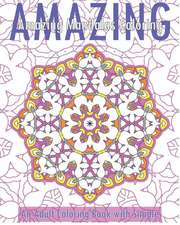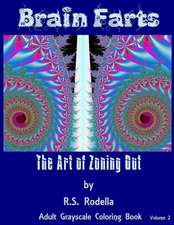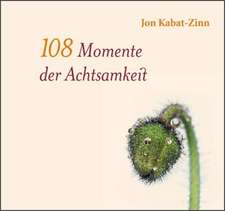Full Catastrophe Living: Using the Wisdom of Your Body and Mind to Face Stress, Pain, and Illness
Thich Nhat Hanh Autor Jon Kabat-Zinnen Limba Engleză Paperback – 23 sep 2013
Stress. It can sap our energy, undermine our health if we let it, even shorten our lives. It makes us more vulnerable to anxiety and depression, disconnection and disease. Based on Jon Kabat-Zinn’s renowned mindfulness-based stress reduction program, this classic, groundbreaking work—which gave rise to a whole new field in medicine and psychology—shows you how to use medically proven mind-body approaches derived from meditation and yoga to counteract stress, establish greater balance of body and mind, and stimulate well-being and healing. By engaging in these mindfulness practices and integrating them into your life from moment to moment and from day to day, you can learn to manage chronic pain, promote optimal healing, reduce anxiety and feelings of panic, and improve the overall quality of your life, relationships, and social networks. This second edition features results from recent studies on the science of mindfulness, a new Introduction, up-to-date statistics, and an extensive updated reading list. Full Catastrophe Living is a book for the young and the old, the well and the ill, and anyone trying to live a healthier and saner life in our fast-paced world.
Praise for Full Catastrophe Living
“One of the great classics of mind/body medicine . . . More than any other, Full Catastrophe Living is the book that enabled Americans to discover the inner life. This book has brought peace of mind to hundreds and thousands of people and healed countless lives. This is your chance to let it heal yours.”—Rachel Naomi Remen, M.D., author of Kitchen Table Wisdom
“A wonderful guidebook for those of us who choose life and healing . . . I hope you all make that choice and read the book.”—Bernie S. Siegel, M.D., author of Love, Medicine & Miracles
“Dr. Jon Kabat-Zinn eloquently explains the power of paying attention and increasing awareness. I strongly recommend this book for everyone who wants to begin healing their life.”—Dean Ornish, M.D., author of Dr. Dean Ornish’s Program for Reversing Heart Disease
Preț: 135.63 lei
Nou
Puncte Express: 203
Preț estimativ în valută:
25.96€ • 26.100$ • 21.43£
25.96€ • 26.100$ • 21.43£
Carte disponibilă
Livrare economică 25 martie-08 aprilie
Livrare express 08-14 martie pentru 38.94 lei
Preluare comenzi: 021 569.72.76
Specificații
ISBN-13: 9780345536938
ISBN-10: 0345536932
Pagini: 650
Dimensiuni: 155 x 234 x 43 mm
Greutate: 0.7 kg
Ediția:Revised, Update
Editura: Bantam
ISBN-10: 0345536932
Pagini: 650
Dimensiuni: 155 x 234 x 43 mm
Greutate: 0.7 kg
Ediția:Revised, Update
Editura: Bantam
Notă biografică
Jon Kabat-Zinn, Ph.D., is a scientist, writer, and meditation teacher engaged in bringing mindfulness into the mainstream of medicine and society. He is professor emeritus of medicine at the University of Massachusetts Medical School, where he was founding executive director of the Center for Mindfulness in Medicine, Health Care, and Society, as well as founder and former director of its world-renowned Stress Reduction Clinic. He is the author of Full Catastrophe Living: Using the Wisdom of Your Body and Mind to Face Stress, Pain, and Illness; Wherever You Go, There You Are: Mindfulness Meditation in Everyday Life; Coming to Our Senses: Healing Ourselves and the World Through Mindfulness; and co-author, with his wife, Myla, of Everyday Blessings: The Inner Work of Mindful Parenting. He lectures and leads retreats on mindfulness-based stress reduction (MBSR) for health professionals worldwide. He received a Pioneer in Integrative Medicine award from the Bravewell Collaborative in 2007 and the 2008 Mind & Brain Prize from the Center for Cognitive Science at the University of Turin, Italy. His books are in print in more than thirty languages.
Extras
Chapter Twelve
Glimpses of Wholeness, Delusions of Separateness
Have you ever looked at a dog and really seen it in its total "dogness"? A dog is quite miraculous when you really see it. What is it? Where did it come from? Where is it going? What is it doing here? Why is it shaped the way it is? What is its "view" of things, of the neighborhood? What are its feelings?
Children tend to think about things this way. Their vision is fresh. They see things as if for the first time every time. Sometimes our seeing gets tired. We just see a dog. "If you've seen one, you've seen them all." So we barely see it at all. We tend to see more through our thoughts and opinions than through our eyes. Our thoughts act as a kind of veil preventing us from seeing things with fresh eyes. What comes into view is identified by the thinking, categorizing mind and quickly framed: a dog. This mind actually prevents us from seeing the dog in its fullness. It processes and categorizes the "dog" signal very quickly in our brain and then moves on to do the same to the next perception or thought.
When my son was two years old, he wanted to know if there was a person inside of our dog. It warmed my heart to see through his eyes in that moment. I knew why he was asking. Sage was a real family member. He had his rightful place. His presence was felt, he participated in the psychic space of the house, he was a complete being, as much a "personality" as any of the people in the family. What could I say to him?
Never mind dogs. What about a bird, or a cat, or a tree, or a flower, or a rhinoceros?! They are all quite miraculous really. When you really look at one, you can hardly believe it exists; there it is, this perfect thing, just being what it is, complete in itself. Any imaginative child could have dreamed up a rhinoceros, or an elephant, or a giraffe. But they didn't get here as the product of a child's imagination. The universe is spinning these dreams. They come out of the universe, as do we.
It doesn't hurt to keep this in mind on a daily basis. It would help us to be more mindful. All life is fascinating and beautiful when the veil of our routinized thinking lifts, even for a moment.
There are many different ways of looking at any thing or event or process. A dog is just a dog. In one way there is nothing special about it; at the same time it is extraordinary, even miraculous. It all depends on how you are looking at it. We might say that it is both ordinary and extraordinary. The dog doesn't change when you change the way you look. It is always just what it is. That is why dogs and flowers and mountains and the sea are such great teachers. They reflect your own mind. It is your mind that changes.
When your mind changes, new possibilities tend to arise. In fact everything changes when you can see things on different levels simultaneously, when you can see fullness and connectedness as well as individuality and separateness. Your thinking expands in scope. This can be a profoundly liberating experience. It can take you beyond your limited preoccupations with yourself. It can put things in a larger perspective. It will certainly change the way you relate to the dog.
When you observe things through the lens of mindfulness, whether it be during formal meditation practice or in daily living, you invariably begin to appreciate things in a new way because your very perceptions change. Ordinary experiences may suddenly be seen as extraordinary. This does not mean that they stop being ordinary. Each is still just what it is. It's just that now you are appreciating them more in their fullness.
Chapter Thirteen
On Healing
When we use the word healing to describe the experiences of people in the stress clinic, what we mean above all is that they are undergoing a profound transformation of view. This transformation is brought about by the encounter with one's own wholeness, catalyzed by the meditation practice. When we glimpse our own completeness in the stillness of any moment, when we directly experience ourself during the body scan or the sitting or while practicing the yoga as whole in that moment and also as part of a larger whole, a new and profound coming to terms with our problems and our suffering begins to take place. We begin to see both ourselves and our problems differently, namely from a perspective of wholeness. This transformation of view creates an entirely different context within which we can see and work with our problems, however serious they may be. It is a perceptual shift away from fragmentation and isolation toward wholeness and connectedness. With this change of perspective comes a shift from feeling out of control and beyond help (helpless and pessimistic) to a sense of the possible, a sense of acceptance and inner peace and control. Healing always involves an attitudinal and emotional transformation. Sometimes, but not always, it is also accompanied by a major reduction in physical symptoms and by improvement in a person's physical condition.
This transformation of view comes about in many different ways as people immerse themselves in mindfulness-meditation practice. In the stress clinic, sometimes people have sudden and dramatic experiences during meditation that lead them to new ways of seeing. More frequently people speak of moments of simply feeling deeply relaxed or confident. Many times they don't even recognize such experiences at the time they are happening as being particularly important, although they often can't remember having had such an experience before. These incremental transformations can be quite subtle. Yet they can be as profound or even more so than the more dramatic ones. Dramatic or subtle, such shifts in perspective are signs of seeing with eyes of wholeness. Out of this shift in perspective comes an ability to act with greater balance and inner security in the world, especially when encountering stress or pain.
Glimpses of Wholeness, Delusions of Separateness
Have you ever looked at a dog and really seen it in its total "dogness"? A dog is quite miraculous when you really see it. What is it? Where did it come from? Where is it going? What is it doing here? Why is it shaped the way it is? What is its "view" of things, of the neighborhood? What are its feelings?
Children tend to think about things this way. Their vision is fresh. They see things as if for the first time every time. Sometimes our seeing gets tired. We just see a dog. "If you've seen one, you've seen them all." So we barely see it at all. We tend to see more through our thoughts and opinions than through our eyes. Our thoughts act as a kind of veil preventing us from seeing things with fresh eyes. What comes into view is identified by the thinking, categorizing mind and quickly framed: a dog. This mind actually prevents us from seeing the dog in its fullness. It processes and categorizes the "dog" signal very quickly in our brain and then moves on to do the same to the next perception or thought.
When my son was two years old, he wanted to know if there was a person inside of our dog. It warmed my heart to see through his eyes in that moment. I knew why he was asking. Sage was a real family member. He had his rightful place. His presence was felt, he participated in the psychic space of the house, he was a complete being, as much a "personality" as any of the people in the family. What could I say to him?
Never mind dogs. What about a bird, or a cat, or a tree, or a flower, or a rhinoceros?! They are all quite miraculous really. When you really look at one, you can hardly believe it exists; there it is, this perfect thing, just being what it is, complete in itself. Any imaginative child could have dreamed up a rhinoceros, or an elephant, or a giraffe. But they didn't get here as the product of a child's imagination. The universe is spinning these dreams. They come out of the universe, as do we.
It doesn't hurt to keep this in mind on a daily basis. It would help us to be more mindful. All life is fascinating and beautiful when the veil of our routinized thinking lifts, even for a moment.
There are many different ways of looking at any thing or event or process. A dog is just a dog. In one way there is nothing special about it; at the same time it is extraordinary, even miraculous. It all depends on how you are looking at it. We might say that it is both ordinary and extraordinary. The dog doesn't change when you change the way you look. It is always just what it is. That is why dogs and flowers and mountains and the sea are such great teachers. They reflect your own mind. It is your mind that changes.
When your mind changes, new possibilities tend to arise. In fact everything changes when you can see things on different levels simultaneously, when you can see fullness and connectedness as well as individuality and separateness. Your thinking expands in scope. This can be a profoundly liberating experience. It can take you beyond your limited preoccupations with yourself. It can put things in a larger perspective. It will certainly change the way you relate to the dog.
When you observe things through the lens of mindfulness, whether it be during formal meditation practice or in daily living, you invariably begin to appreciate things in a new way because your very perceptions change. Ordinary experiences may suddenly be seen as extraordinary. This does not mean that they stop being ordinary. Each is still just what it is. It's just that now you are appreciating them more in their fullness.
Chapter Thirteen
On Healing
When we use the word healing to describe the experiences of people in the stress clinic, what we mean above all is that they are undergoing a profound transformation of view. This transformation is brought about by the encounter with one's own wholeness, catalyzed by the meditation practice. When we glimpse our own completeness in the stillness of any moment, when we directly experience ourself during the body scan or the sitting or while practicing the yoga as whole in that moment and also as part of a larger whole, a new and profound coming to terms with our problems and our suffering begins to take place. We begin to see both ourselves and our problems differently, namely from a perspective of wholeness. This transformation of view creates an entirely different context within which we can see and work with our problems, however serious they may be. It is a perceptual shift away from fragmentation and isolation toward wholeness and connectedness. With this change of perspective comes a shift from feeling out of control and beyond help (helpless and pessimistic) to a sense of the possible, a sense of acceptance and inner peace and control. Healing always involves an attitudinal and emotional transformation. Sometimes, but not always, it is also accompanied by a major reduction in physical symptoms and by improvement in a person's physical condition.
This transformation of view comes about in many different ways as people immerse themselves in mindfulness-meditation practice. In the stress clinic, sometimes people have sudden and dramatic experiences during meditation that lead them to new ways of seeing. More frequently people speak of moments of simply feeling deeply relaxed or confident. Many times they don't even recognize such experiences at the time they are happening as being particularly important, although they often can't remember having had such an experience before. These incremental transformations can be quite subtle. Yet they can be as profound or even more so than the more dramatic ones. Dramatic or subtle, such shifts in perspective are signs of seeing with eyes of wholeness. Out of this shift in perspective comes an ability to act with greater balance and inner security in the world, especially when encountering stress or pain.
Recenzii
“One of the great classics of mind/body medicine . . . More than any other, Full Catastrophe Living is the book that enabled Americans to discover the inner life. This book has brought peace of mind to hundreds and thousands of people and healed countless lives. This is your chance to let it heal yours.”—Rachel Naomi Remen, M.D., author of Kitchen Table Wisdom
“A wonderful guidebook for those of us who choose life and healing . . . I hope you all make that choice and read the book.”—Bernie S. Siegel, M.D., author of Love, Medicine & Miracles
“Dr. Jon Kabat-Zinn eloquently explains the power of paying attention and increasing awareness. I strongly recommend this book for everyone who wants to begin healing their life.”—Dean Ornish, M.D., author of Dr. Dean Ornish’s Program for Reversing Heart Disease
“A wonderful guidebook for those of us who choose life and healing . . . I hope you all make that choice and read the book.”—Bernie S. Siegel, M.D., author of Love, Medicine & Miracles
“Dr. Jon Kabat-Zinn eloquently explains the power of paying attention and increasing awareness. I strongly recommend this book for everyone who wants to begin healing their life.”—Dean Ornish, M.D., author of Dr. Dean Ornish’s Program for Reversing Heart Disease















